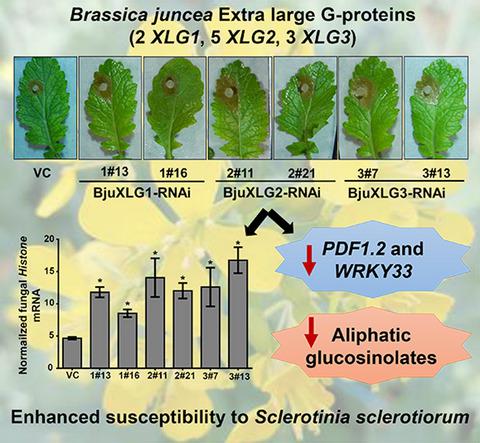当前位置:
X-MOL 学术
›
Mol. Plant Pathol.
›
论文详情
Our official English website, www.x-mol.net, welcomes your
feedback! (Note: you will need to create a separate account there.)
Extra-large G-proteins influence plant response to Sclerotinia sclerotiorum by regulating glucosinolate metabolism in Brassica juncea
Molecular Plant Pathology ( IF 4.8 ) Pub Date : 2021-08-10 , DOI: 10.1111/mpp.13096 Ruchi Tiwari 1 , Jagreet Kaur 2 , Naveen C Bisht 1
Molecular Plant Pathology ( IF 4.8 ) Pub Date : 2021-08-10 , DOI: 10.1111/mpp.13096 Ruchi Tiwari 1 , Jagreet Kaur 2 , Naveen C Bisht 1
Affiliation

|
Heterotrimeric G-proteins are one of the highly conserved signal transducers across phyla. Despite the obvious importance of G-proteins in controlling various plant growth and environmental responses, there is no information describing the regulatory complexity of G-protein networks during pathogen response in a polyploid crop. Here, we investigated the role of extra-large G-proteins (XLGs) in the oilseed crop Brassica juncea, which has inherent susceptibility to the necrotrophic fungal pathogen Sclerotinia sclerotiorum. The allotetraploid B. juncea genome contains multiple homologs of three XLG genes (two BjuXLG1, five BjuXLG2, and three BjuXLG3), sharing a high level of sequence identity, gene structure organization, and phylogenetic relationship with the progenitors’ orthologs. Quantitative reverse transcription PCR analysis revealed that BjuXLGs have retained distinct expression patterns across plant developmental stages and on S. sclerotiorum infection. To determine the role of BjuXLG genes in the B. juncea defence response against S. sclerotiorum, RNAi-based suppression was performed. Disease progression analysis showed more rapid lesion expansion and fungal accumulation in BjuXLG-RNAi lines compared to the vector control plants, wherein suppression of BjuXLG3 homologs displayed more compromised defence response at the later time point. Knocking down BjuXLGs caused impairment of the host resistance mechanism to S. sclerotiorum, as indicated by reduced expression of defence marker genes PDF1.2 and WRKY33 on pathogen infection. Furthermore, BjuXLG-RNAi lines showed reduced accumulation of leaf glucosinolates on S. sclerotiorum infection, wherein aliphatic glucosinolates were significantly compromised. Overall, our data suggest that B. juncea XLG genes are important signalling nodes modulating the host defence pathways in response to this necrotrophic pathogen.
中文翻译:

超大 G 蛋白通过调节芥菜中硫代葡萄糖苷代谢影响植物对核盘菌的反应
异三聚体 G 蛋白是跨门高度保守的信号转导子之一。尽管 G 蛋白在控制各种植物生长和环境反应方面具有明显的重要性,但没有信息描述 G 蛋白网络在多倍体作物病原体反应期间的调节复杂性。在这里,我们研究了超大 G 蛋白 (XLG) 在油料作物芥菜中的作用,该作物对坏死性真菌病原体核盘菌 具有内在的敏感性。异源四倍体B . juncea基因组包含三个XLG基因的多个同源物(两个BjuXLG1、五个BjuXLG2和三个BjuXLG3 ),与祖先的直系同源物共享高水平的序列同一性、基因结构组织和系统发育关系。定量逆转录 PCR 分析表明,BjuXLGs在植物发育阶段和S上保留了不同的表达模式。 菌核感染。确定BjuXLG基因在B中的作用。 芥菜对S的防御反应。 菌核, 进行了基于 RNAi 的抑制。疾病进展分析显示,与载体对照植物相比,BjuXLG-RNAi 系中的病灶扩张和真菌积累更快,其中BjuXLG3同源物的抑制在后期时间点显示出更受损的防御反应。击倒BjuXLGs导致宿主对S的抗性机制受损。 核盘菌,如防御标记基因PDF1.2和WRKY33在病原体感染时的表达减少所示。此外,BjuXLG-RNAi 系显示叶硫代葡萄糖苷在S上的积累减少。 菌核感染,其中脂肪族硫代葡萄糖苷显着受损。总的来说,我们的数据表明B . juncea XLG基因是调节宿主防御途径以响应这种坏死性病原体的重要信号节点。
更新日期:2021-09-12
中文翻译:

超大 G 蛋白通过调节芥菜中硫代葡萄糖苷代谢影响植物对核盘菌的反应
异三聚体 G 蛋白是跨门高度保守的信号转导子之一。尽管 G 蛋白在控制各种植物生长和环境反应方面具有明显的重要性,但没有信息描述 G 蛋白网络在多倍体作物病原体反应期间的调节复杂性。在这里,我们研究了超大 G 蛋白 (XLG) 在油料作物芥菜中的作用,该作物对坏死性真菌病原体核盘菌 具有内在的敏感性。异源四倍体B . juncea基因组包含三个XLG基因的多个同源物(两个BjuXLG1、五个BjuXLG2和三个BjuXLG3 ),与祖先的直系同源物共享高水平的序列同一性、基因结构组织和系统发育关系。定量逆转录 PCR 分析表明,BjuXLGs在植物发育阶段和S上保留了不同的表达模式。 菌核感染。确定BjuXLG基因在B中的作用。 芥菜对S的防御反应。 菌核, 进行了基于 RNAi 的抑制。疾病进展分析显示,与载体对照植物相比,BjuXLG-RNAi 系中的病灶扩张和真菌积累更快,其中BjuXLG3同源物的抑制在后期时间点显示出更受损的防御反应。击倒BjuXLGs导致宿主对S的抗性机制受损。 核盘菌,如防御标记基因PDF1.2和WRKY33在病原体感染时的表达减少所示。此外,BjuXLG-RNAi 系显示叶硫代葡萄糖苷在S上的积累减少。 菌核感染,其中脂肪族硫代葡萄糖苷显着受损。总的来说,我们的数据表明B . juncea XLG基因是调节宿主防御途径以响应这种坏死性病原体的重要信号节点。











































 京公网安备 11010802027423号
京公网安备 11010802027423号